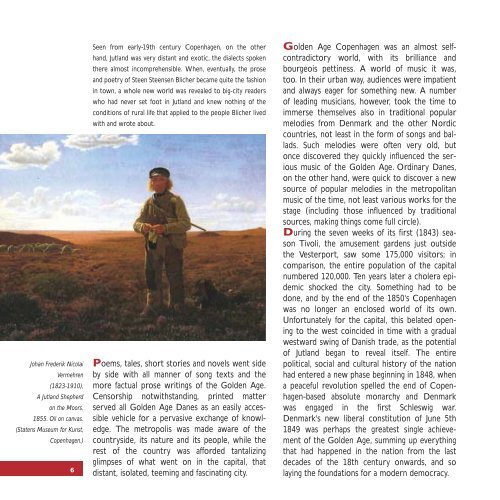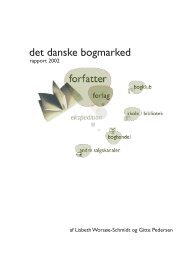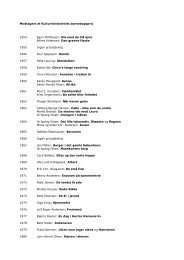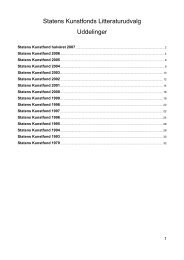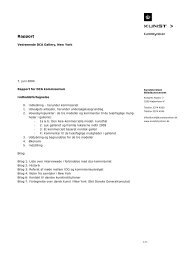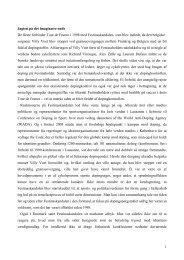Danish Music: The Golden Age 1800-1850
Danish Music: The Golden Age 1800-1850
Danish Music: The Golden Age 1800-1850
You also want an ePaper? Increase the reach of your titles
YUMPU automatically turns print PDFs into web optimized ePapers that Google loves.
Johan Frederik Nicolai<br />
Vermehren<br />
(1823-1910),<br />
A Jutland Shepherd<br />
on the Moors.<br />
1855. Oil on canvas.<br />
(Statens Museum for Kunst,<br />
Copenhagen.)<br />
6<br />
Seen from early-19th century Copenhagen, on the other<br />
hand, Jutland was very distant and exotic, the dialects spoken<br />
there almost incomprehensible. When, eventually, the prose<br />
and poetry of Steen Steensen Blicher became quite the fashion<br />
in town, a whole new world was revealed to big-city readers<br />
who had never set foot in Jutland and knew nothing of the<br />
conditions of rural life that applied to the people Blicher lived<br />
with and wrote about.<br />
Poems, tales, short stories and novels went side<br />
by side with all manner of song texts and the<br />
more factual prose writings of the <strong>Golden</strong> <strong>Age</strong>.<br />
Censorship notwithstanding, printed matter<br />
served all <strong>Golden</strong> <strong>Age</strong> Danes as an easily accessible<br />
vehicle for a pervasive exchange of knowledge.<br />
<strong>The</strong> metropolis was made aware of the<br />
countryside, its nature and its people, while the<br />
rest of the country was afforded tantalizing<br />
glimpses of what went on in the capital, that<br />
distant, isolated, teeming and fascinating city.<br />
<strong>Golden</strong> <strong>Age</strong> Copenhagen was an almost selfcontradictory<br />
world, with its brilliance and<br />
bourgeois pettiness. A world of music it was,<br />
too. In their urban way, audiences were impatient<br />
and always eager for something new. A number<br />
of leading musicians, however, took the time to<br />
immerse themselves also in traditional popular<br />
melodies from Denmark and the other Nordic<br />
countries, not least in the form of songs and ballads.<br />
Such melodies were often very old, but<br />
once discovered they quickly influenced the serious<br />
music of the <strong>Golden</strong> <strong>Age</strong>. Ordinary Danes,<br />
on the other hand, were quick to discover a new<br />
source of popular melodies in the metropolitan<br />
music of the time, not least various works for the<br />
stage (including those influenced by traditional<br />
sources, making things come full circle).<br />
During the seven weeks of its first (1843) season<br />
Tivoli, the amusement gardens just outside<br />
the Vesterport, saw some 175,000 visitors; in<br />
comparison, the entire population of the capital<br />
numbered 120,000. Ten years later a cholera epidemic<br />
shocked the city. Something had to be<br />
done, and by the end of the <strong>1850</strong>'s Copenhagen<br />
was no longer an enclosed world of its own.<br />
Unfortunately for the capital, this belated opening<br />
to the west coincided in time with a gradual<br />
westward swing of <strong>Danish</strong> trade, as the potential<br />
of Jutland began to reveal itself. <strong>The</strong> entire<br />
political, social and cultural history of the nation<br />
had entered a new phase beginning in 1848, when<br />
a peaceful revolution spelled the end of Copenhagen-based<br />
absolute monarchy and Denmark<br />
was engaged in the first Schleswig war.<br />
Denmark's new liberal constitution of June 5th<br />
1849 was perhaps the greatest single achievement<br />
of the <strong>Golden</strong> <strong>Age</strong>, summing up everything<br />
that had happened in the nation from the last<br />
decades of the 18th century onwards, and so<br />
laying the foundations for a modern democracy.


